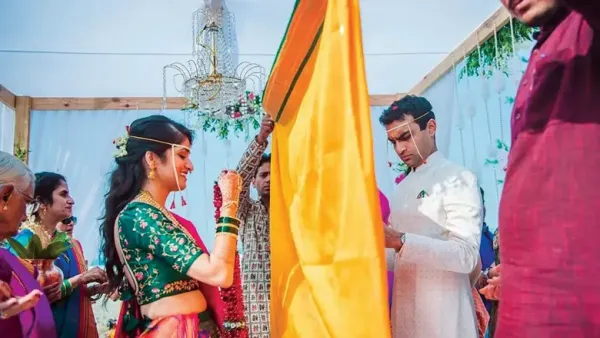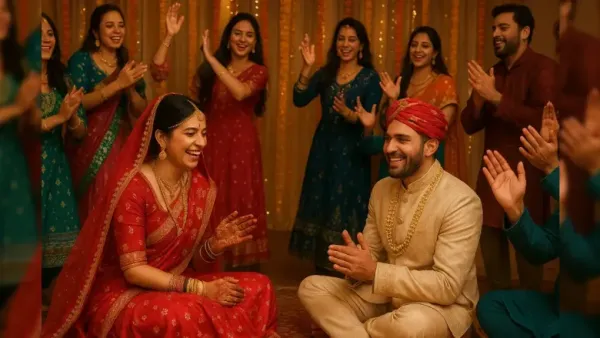
Unique Indian Wedding Rituals: Indian weddings are not just a union of two people but a celebration of customs, colors and relationships. The unique rituals of every state offer a glimpse of the cultural richness and unity of this country.
Marriage in India is not just a relationship but a sacred sacrament wrapped in layers of tradition. Here, a different color resides in every state, every language and every custom. Come, let us know about different countries
Here are 10 amazing marriage rituals that touch the soul of our civilization.
There is a beautiful tradition of Antarpat in Marathi marriages. When the marriage rituals begin, a silk curtain is placed between the bride and groom. This curtain remains between them until
Unless the Pandit ji declares an auspicious time.
When the curtain is removed, the two see each other as husband and wife for the first time.
In Gujarat, a few days before the marriage, the bride’s maternal uncles and aunts are given special respect. In this ritual called Mameru or Mosalu, the maternal uncle comes to his niece’s house and presents her with sarees, jewellery, sweets and gifts.

In some communities of South India, a fun custom performed just before the wedding is Kashi Yatra. In this ritual, the groom ostensibly announces his intention to elope from the marriage and sets out on a journey to ‘Kashi’ with the intention of becoming a monk. With a stick in his hand, slippers on his feet and a cap on his head, it seemed as if he had set out in search of knowledge, but then the bride’s father and
The brothers arrive, console her and convince her for the marriage.
The last ritual of marriage in Manipur is Naga-Thaba. In this ritual, women from both the families together release two fishes in the pond, one from the groom’s side and one from the bride’s side. If the fishes swim together, it is believed that the couple will live together in harmony and love throughout their life.

Kashmir weddings are a beautiful confluence of music and tradition. Before the marriage, there is a ritual called Wanwun, in which women sing traditional songs. These songs are not just entertainment, but also a medium to bless the bride and prepare her for her new life. The house is first subjected to a purification called liwun. The entire house is cleaned, fragrant mud is applied to the walls, and in the evening one sits near the hearth fire and sings the songs of wanwun. Also served is Noon Chai, which is pink salted tea and adds warmth to every relationship.
Toran Bandhan is an interesting tradition in the marriage rituals in the Rajput community of Rajasthan. A Toran is tied at the entrance of the wedding venue from the bride’s side. When the groom reaches there, the bride symbolically moves towards him with a sword as if she is testing his bravery. The groom also smiles in the same manner and promises ‘protection’. This tradition is a symbol of love, respect and courage where the foundation of the relationship is laid on equality and mutual respect.
In Bengal, a wedding begins with a sacred ritual called Ganga Invitation. A few days before the wedding, early in the morning the married women of the bride’s house go out to invite Ganga Mata to the wedding. She goes to the river bank carrying sweets, lamps and incense in a puja thali and prays that like the Ganga water, her daughter’s life also remains pure and fragrant. This ritual tells that
How deeply spirituality and motherly love are linked in Bengali culture.
In Sarsaul region of Uttar Pradesh, the way of welcoming weddings is a little different. Here, on the arrival of the wedding procession, not flowers but tomatoes are thrown at the guests! It may sound strange, but this fun ritual is a symbol of love and fun. It is believed that if the marriage starts with a little laughter and noise, the relationship becomes more lively.
The form of marriage procession in Uttarakhand and Himachal Pradesh is very unique. Here a white flag is waved in front of the groom’s procession. Drums are played, songs are sung and the entire valley
There is a festival like celebration. After the wedding, when the bride departs, a red flag is hoisted in front of her palanquin. Both of these flags symbolize the union of the two families, white and red, which now
Are painted in one color.
In some parts of Bihar, when the bride enters the courtyard of her in-laws’ house after marriage, her mother-in-law places several earthen pots on her head. The bride was seen balancing those pitchers by the elders.
Feet have to be touched. The more easily she does this, the more she is believed to be adept at balancing responsibilities in the new home.